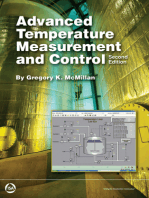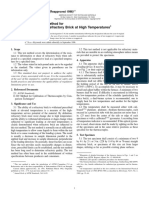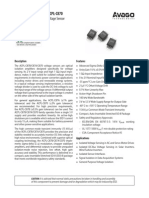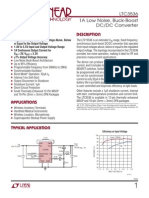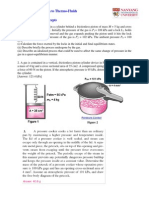Turbine Controls Limited Leicester, United Kingdom
Turbine Controls Limited Leicester, United Kingdom
Uploaded by
r_chulinCopyright:
Available Formats
Turbine Controls Limited Leicester, United Kingdom
Turbine Controls Limited Leicester, United Kingdom
Uploaded by
r_chulinOriginal Title
Copyright
Available Formats
Share this document
Did you find this document useful?
Is this content inappropriate?
Copyright:
Available Formats
Turbine Controls Limited Leicester, United Kingdom
Turbine Controls Limited Leicester, United Kingdom
Uploaded by
r_chulinCopyright:
Available Formats
THE AMERICAN SOCIETY OF MECHANICAL ENGINEERS
345 E. 47th St., New York, N.Y. 10017
The Society shall not be responsible for statements or opinions advanced in 94-GT-189
papers or discussion at meetings of the Society or of its Divisions or Sections,
m or printed in its publications. Discussion is printed only if the paper is pub-
lished in an ASME Journal. Papers are available from ASME for 15 months
after the meeting.
Copyright 1994 by ASME
Printed in U.S.A.
GAS TURBINE TEMPERATURE SPREAD MONITORING
DETECTION OF COMBUSTION SYSTEM DETERIORATION
Martin Knowles
Turbine Controls Limited
Leicester, United Kingdom
ABSTRACT
deteriorate and in some cases break up. Deteriorations in
Deterioration in the burners or combustion chamber of a any of the components may result in a change in gas flow
gas turbine can result in uneven and unstable air flow and stability and the temperature profile. Either of these
excessive temperature profiles, any of which will produce effects would subject components in the hot gas path to
unnecessary and potentially damaging stress cycles. increased stress cycles.
Detection relies on comparisons of thermocouples located Temperature profiles can be monitored using
circumferentially at a convenient point in the hot gas path. thermocouple rings located at a convenient section of the
The techniques usually recommended by engine hot gas path. The technique is called Temperature
manufacturers compare absolute values taking no account Spread Monitoring (TSM) and is widely used as part of
of any initial asymmetry due to manufacturing tolerances, engine health monitoring systems within the gas turbine
thermocouple positioning or turbulence of the gas flow at industry. The initial component deterioration may be
the measurement point. detected by temperature spread monitoring resulting in
unscheduled shutdown. However, damage will have been
The initial profile of measured temperatures can be limited. If left undetected, the consequential damage due
established empirically over the operating range and it is to either debris passing through the hot gas path or the
deviation from this profile which provides a sensitive effects of excessive stress cycles on blading can be
measure of deterioration in the combustion system. This enormous.
more sensitive technique provides earlier detection of
impending failure. In the majority of cases, the engine manufacturer
recommends some form of comparison between any
This paper reviews the normally recommended approach, individual temperature with either the average or adjacent
presents the case for detecting departure from the footprint or opposite measurements or a comparison of the
and looks at a case study. extremes.
This paper considers:
1 INTRODUCTION a) the perfect hot gas path,
b) the cause of abnormalities in the profile,
Gas turbines have combustion chamber(s) and burners c) the potential deterioration or malfunction,
which, if perfect, would give a symmetrical temperature d) some examples of how engine manufacturers
distribution around a cross section of the hot gas path. recommend detection of deterioration using
Manufacturing tolerances will result in some deviation from temperature spread monitoring based on absolute
this symmetry. Obstructions such as struts in the hot gas variations,
path cause a disturbance to the gas flow symmetry. e) the validity of the manufacturer's recommended
approach,
The combustion chambers, burners and obstructions do f) an alternative approach based on departure from a
Presented at the International Gas Turbine and Aeroengine Congress and Exposition
The Hague, Netherlands - June 13-16, 1994
Downloaded From: http://asmedigitalcollection.asme.org/pdfaccess.ashx?url=/data/conferences/asmep/82323/ on 09/02/2017 Terms of Use: http://www.asme.org/about-asme/term
footprint derived empirically when the engine was "as Deviation
new". from Average
g) a case study on Olympus SK30 gas turbines operating
in the North Sea north east of the British Isles.
Cir(umfe rent ial
2 THE PERFECT COMBUSTION SYSTEM Distance
Figure 2 Perfect Temperature Profile at a
Consider the case of an eight burner gas generator with
eight combustion chambers. Rolls Royce Avons and Circumferential Point
Olympuses are examples of this. Other configurations are:
a) different number of burners and combustion chambers, Eight thermocouples perfectly located to coincide with
for example the General Electric industrial series of gas combined with the perfect combustion would result in no
turbines, measured temperature spread.
b) multi burners but annular combustion chambers as on 3 CONSIDERATION OF THE EFFECT OF OBSTRUCTIONS
Rolls Royce RB21 1 and General Electric aero-derivative
LM series of engines, although the Dry Low NOX RB21 1 From the combustion chambers, the hot gases pass
falls into category a). through a combination of stators, rotors and struts before
exiting from the rear of the gas generator or to wherever
Whatever the configuration the principle remains the the temperature spread monitoring thermocouples have
same: If the combustion is perfect and without any been located. Three effects will have occurred:
disturbances to the flow, the temperature profile on exit
from the combustion chambers will be symmetrical a) the hot spots will have rotated with respect to the
around the centre line of the burners, see figure 1. burners due to the effects of swirl. The degree of
rotation will vary with operating point.
b) there will be considerable mixing which will diminish
the amplitude of the temperature profile compared with
the profile at exit from the combustion chamber.
c) there will be distortion of the air flow due to the
number of struts being different from the number of
burners resulting in an asymmetric temperature profile.
These effects are shown in figure 3.
Deviation
from Average
Cir umferential
Distance
Figure 3 Circumferential Profile Distorted with
Diminished Amplitude at Gas Generator Exhaust
Figure 1 Perfect Circumferential Temperature 4 Consideration of The Effect of Thermocouple Position
Contours at Combustion Chamber Exit Error
In order to monitor the temperature profile, a ring of
The temperature profile at a circumferential ring about the equispaced thermocouples is placed circumferentially in
axis of the gas generator will be symmetrical. See figure 2. the hot gas path either at gas generator exhaust or power
turbine entry or in some cases at power turbine exhaust.
Downloaded From: http://asmedigitalcollection.asme.org/pdfaccess.ashx?url=/data/conferences/asmep/82323/ on 09/02/2017 Terms of Use: http://www.asme.org/about-asme/term
In the case of the Avon or Olympus, the number of Circumferential
)eviction
thermocouples equals the number of burners i.e the Therm ocouple Location
rorn Average
symmetry of the temperature profile is matched by the
symmetry of positioning of the thermocouples. However
the insertion depth and circumferential spacing, see figure
4, present the possibility of position error resulting in an ir6umfe rent ial
asymmetric measurement. istance
Figure 6 Circumferential Profile and Location of
Thermocouples
5 Consideration of The Effect of Manufacturing
Tolerances
There will be differences in the burners and combustion
system which are quite acceptable but which will none
the less contribute to the degree of asymmetry.
Variations in burner geometry will give rise to variations
in either the fuel flow pattern into the combustion
chamber or relative flow between burners. Air flow into
the combustion chambers will vary due to either
geometrical differences between combustion chambers or
asymmetric flow from the compressor stages of the gas
generator.
There is a level of tolerance dictated by the engine
manufacturers which is acceptable with a new engine.
6 The Combined Effect of Imperfections On Temperature
Monitoring
Figure 4 Thermocouple Positioning
The circumferential temperature measurements at the
designated station when taken from an asymmetric profile
The depth of radial insertion of the thermocouple into the combined with position errors will result in a measured
gas path has a significant effect on the temperature temperature spread when the engine is completely
measured as shown in figure 5. healthy, see figures 7 and 8.
Deviation Deviation
frnrri Average
I
\J `' kj / Circtmferential
Distance
Figure 7 Actual Circumferential Profile at
Measurement Point
Figure 5 Radial Temperature Profile
The circumferential spacing of the thermocouples will
likewise have a significant effect on the temperature
measured as shown in figure 6.
When the number of thermocouples differs from the
number of burners then it is unlikely that the measurement
points will coincide with the symmetry of the temperature
profile consequently it could be expected that the
measurements would not possess any symmetry.
Downloaded From: http://asmedigitalcollection.asme.org/pdfaccess.ashx?url=/data/conferences/asmep/82323/ on 09/02/2017 Terms of Use: http://www.asme.org/about-asme/term
Deviation Deviation
from Average f ro rn..Average--------------------------------------------------------.....-------.....Tri p
.............................. .. .. .............. .............................................Alprm
......... . .............................. ........------- ------....... Alprm
1 2 3 4 5 6 7 8 ................................................................................................ T n p
Figure 8 Bar Chart of Measured Deviation
Figure 9 Extreme of Acceptable Temperature
from Average
Spread
7 Conventional Temperature Spread Monitoring
Techniques and Their Deficiencies
b) An 89 deg C may not be alarmed when there may be
Techniques for comparing thermocouples and taking considerable damage occurring.
specific action do vary between the various gas turbine
manufacturers. Three examples are: 8 THE PURPOSE OF TEMPERATURE SPREAD
MONITORING
a) compare each individual temperature with the average.
Then alarm and trip levels are defined for the difference, The purposes of temperature spread monitoring are to:
b) compare each thermocouple with either adjacent and/or a) prevent excess thermal stress to hot gas path
opposite thermocouples to define alarm and trip actions, components,
c) compare the extremes of measurement. b) detect any deterioration or combustion malfunction
which may result in catastrophic damage and
Each of these techniques compares absolute values rather consequential long term unscheduled shutdown,
than a relative change. Compensation for the probable and
reasonable temperature measurement profile which may c) identify any deterioration which can be investigated at
occur for the reasons discussed cannot be included in a the next planned shutdown and appropriate repairs be
technique which compares absolute values. These made,
techniques therefore have to compromise engine safety
and health monitoring for operational reliability by d) detect flame failure or failure to light.
extending the alarm and trip settings. The effect of this is
to permit large changes to the temperature profile to occur The traditional techniques based on absolute deviations
without being alarmed and in other instances cause do not meet the second requirement adequately and
nuisance alarms. For example using the comparison with barely address the third requirement at all.
average approach in a) above, (the scenario can be applied
equally to all three techniques): The fourth requirement of flame failure or fail to light
may not be detected if 1) at the measurement point there
With an alarm level set at 50 deg C from the average, any has been considerable mixing of the hot gas due to
individual thermocouple may be 40 deg C low in the "as turbulence and 2) the thermocouple associated with the
new" condition and therefore be considered acceptable, failed burner was reading high when in the "as new"
see figure 9. It may be argued that this should not be condition.
accepted as satisfactory but it is a typical engine
manufacturer's pass off criteria. 9 THE CONCEPT OF NORMALISED TEMPERATURE
SPREAD MONITORING
a 10 deg C movement lower and an alarm would be given
Three of the four requirements of temperature spread
an 89 deg C movement higher would not raise an alarm monitoring, established above, are for the detection of
combustion system deterioration. Deterioration implies a
Neither of these conditions is acceptable. change and therefore a technique which recognises a
change in the measured profile, rather than comparing
a) A 10 deg C movement would be viewed as a nuisance absolute values, should be found. The hypothesis is that
alarm resulting in operators taking minimal notice of the a change in the temperature spread will detect a
alarm. This may subsequently affect their judgment and component deterioration at a much earlier stage than
perhaps take delayed action for an 90 deg C movement. absolute temperature spread. It is therefore proposed to:
Downloaded From: http://asmedigitalcollection.asme.org/pdfaccess.ashx?url=/data/conferences/asmep/82323/ on 09/02/2017 Terms of Use: http://www.asme.org/about-asme/term
a) establish empirically the temperature profiles for each a) establish the sample points either side of the
individual engine throughout its operating range when operating average temperature
b) interpolate the footprint temperature for each
the engine is in an "as new" state. i.e a "footprint".
thermocouple
b) confirm the temperature profile is acceptable to the
engine manufacturer Tave-Tf
Tni= *(Tn, fh-Tn.)^+Tnf
c) engine health monitoring, alarm action and trip action be T, fh-V
based on the deviation from the footprint profile and this
deviation be known as "Normalised Temperature T,, =The interpolated footprint temperature for
;
Spread". thermocouple n
T ay " = The current average temperature
10 A CASE STUDY EXAMPLE WHERE NORMALISED TSM T, =The footprint average temperature below the
WOULD HAVE PREVENTED CATASTROPHIC FAILURE current average
T f,, =The footprint average temperature above the
10.1 The Situation current average
T,,, =The footprint temperature of thermocouple n for
There are 4 Olympus SK30 power generation sets the sample below the current average
operating on an offshore oil platform in the northern sector T",,, =The footprint temperature of thermocouple n for
of the North Sea north east of the British Isles. The units the sample above the current average
are dual fuelled (natural gas and diesel). There are 8
thermocouples located at power turbine inlet. A Because this normalised technique was not known to be
temperature profile is a set of the 8 thermocouple readings used anywhere else and not recognised by the engine
at any one point in the operating range. manufacturer, the alarm and trip levels were set
cautiously high to avoid nuisance alarms at 40 and 60
There had been problems with liquid carryover in the gas deg C respectively. The plan was to gain experience
fuel which resulted in combustion outside the combustion whilst not bringing the technique into disrepute.
chamber. This resulted in considerable damage to the High
Pressure Turbine blades. Because of all the considerations It should be noted that the engine manufacturer's
made earlier, absolute temperature spread monitoring did recommendations on absolute deviation from the average
not protect against this major combustion abnormality. were also implemented.
After several engine failures, the operator decided to 10.3 Hardware Implementation
implement improved temperature spread monitoring with
the aim of detecting combustion malfunction. Paper trace The hardware implementation used 8 isolated
recordings revealed very clear profiles over the operating thermocouple input conditioning and a microprocessor
range and that the profiles were maintained over protracted with communication to a high resolution touch sensitive
operating periods, confirming the belief that a unique screen, see figure 10.
footprint could be established. Normalised Temperature
Spread Monitoring was implemented in addition to the The screen provided graphical display capability whilst
engine manufacturers requirement of absolute deviation the microprocessor memory provided data storage
from the average. A new TSM was required. capability. Both capabilities enabled additional features to
be included:
10.2 Implementation Of Normalised TSM
historic event recording
The footprint was established by storing the measured
temperature spread profile at 8 sample points nominally data storage allowing graphic display of all
equispaced through the operating range for each fuel. The temperatures for the 40 seconds at 100 mSecs
samples were taken at approximately 50 degree intervals intervals and the 40 minutes at 6 second interval
starting at 400 deg C. Each sample profile was referenced before a shutdown.
to the average temperature. Average temperature was
used for referencing rather than some other engine maintenance modes to allow forcing of I/O,
parameter, such as speed or compressor delivery pressure, adjustment of parameters, resetting alarm history,
because this did not require any further signal inputs. password protection.
Using linear interpolation, a normalised deviation is automatic configuration of the footprint data with the
determined by comparing the thermocouple reading with running engine.
the expected footprint value. The interpolation requires:
Downloaded From: http://asmedigitalcollection.asme.org/pdfaccess.ashx?url=/data/conferences/asmep/82323/ on 09/02/2017 Terms of Use: http://www.asme.org/about-asme/term
light up of all combustion chambers confirmed by all
thermocouples being above light up temperature Time Observation
before achieving idle.
08:38:50 T/C 5 Absolute Deviation Low
08:39:39 T/C 2 Normalised Deviation High
08:39:39 T/C 3 Normalised Deviation High
POWER SUPPLY
08:40:59 T/C 4 Normalised Deviation Low
MICROPROCCESSOR BOARD
INTEL 00188 PROCESSOR
129K RAM
08:43:02 T/C 1 Normalised Deviation High
129K EPROM
THERMOCOUPLE 08:43:49 T/C 1 Absolute Deviation High
cOMMS BOARD RELAY MODULE
BOARD
08:43:59 Unit Tripped on vibration
HIGH RESOUJT1ON LEI LJ ^/^
T iSENBRIVE
GRAPHICS DISPLAY THERMOCOUIE BIDIrALS Table 1 Sequence of Alarms
PLANT CONTROL
FROM PLANT SIGNALS
10.5 The Analysis
Figure 10 TSM Hardware It would seem likely that the alarms on thermocouples
1, 2 & 3 were associated with the change in the
combustion processes and air flow distribution resulting
10.4 The Incident from the partial blockage of burner nozzles 7, 8 & 1. The
event was observable through the historic data storage
In October 1992 an Olympus failed as a result of the built into the TSM which allows the temperatures to be
release of an HP turbine blade. Subsequent investigations displayed for 40 seconds and 40 minutes prior to the trip.
revealed that the failure had resulted from resonant high The shift between burners and thermocouples is
cycle fatigue, probably brought on by increased airflow attributed to the rotation of the gas stream between the
excitation due to the partial blockage of three adjacent gas generator combustor outlet and the power turbine
burner nozzles. The report by the engine repair company mounted thermocouples.
went on to suggest that air flow excitation would have
resulted in damage occurring in a matter of minutes but The absolute temperature spread monitoring had
would not have shown up in exhaust gas temperature produced an alarm but not sufficient deviation to cause a
spread measurements. trip. (see figure 11)
In fact the temperature spread monitor had raised the
alarm. The event logging facility which is built in to the
TSM revealed the alarm sequence shown in table 1
TRIP
This means that during the five minute period prior to the .......... ............. . .. . .......
AIARM .......................................-
machine tripping, two temperature spread absolute
deviation alarms and four normalized deviation alarms were
recorded. Three of the four normalized deviation alarms _I -1T ^ 1tJ_ _
were 'high deviation' on thermocouples 1, 2 & 3 and one
of the absolute deviation alarms was 'high deviation' on
^ r
thermocouple 1. .............................................. ....................... ....._._.............
ALARM
TRIP
Due to the nature of the Alarm Annunciation device, the
operator would have only been advised that an alarm was
present. Once one alarm had been annunciated, the system
would not annunciate the fact that further thermocouples
were in the alarm state. For this reason, the operator
Figure 11 Absolute Temperature Spread Pattern
would not have been aware of the profusion of deviation
alarms that occurred in the five minutes prior to the
incident, other than by continuously observing the TSM
display. The pattern had changed significantly (see figure 12)
Downloaded From: http://asmedigitalcollection.asme.org/pdfaccess.ashx?url=/data/conferences/asmep/82323/ on 09/02/2017 Terms of Use: http://www.asme.org/about-asme/term
giving rise to multiple normalised alarms. The levels for the
normalised alarm and trip had been derived during the initial 10.6 Recommendations Following the Incident
commissioning of the TSM only as "reasonable estimates".
Confidence in the Normalised technique was being The operator should be provided with indication of
established. multiple deviation alarms via the Unit Control Panel
mounted Alarm Annunciator.
The values of the normalised deviation alarm and trip set
points should be reduced in order to provide increased
TRIP sensitivity. The revised settings should be set as low as
........ ALARM possible without introducing 'nuisance' alarms and trips.
The revised values should be based on operational
experience and observation.
1
..............................................
ALARM
Should it prove impossible to reduce the normalised
settings sufficiently without incurring unacceptably
frequent 'spurious' trips, then a technique should be
TRIP developed to trip the machine if a number of alarms are
present at any one time.
Figure 12 Normalised Temperature Spread Pattern 11 GENERAL CONCLUSIONS
A temperature spread will be present on an "as new"
healthy engine for reasons of manufacturing tolerances,
gas flow stability and thermocouple location.
Conventional techniques using absolute variations of
10.5.1 Condusions from the Incident. individual measurements are not adequately sensitive to
component deterioration.
The failure was a result of the partial blockage of several
burner nozzles by debris from the off engine fuel filter. The Techniques which establish a footprint of temperature
blockage was sufficient to cause increased airflow spread "as new" and detect departure from the footprint
excitation and high cycle fatigue failure of one HP turbine do provide increased sensitivity in the detection of
blade. deterioration and malfunctions.
During the five minute period prior to the failure, the 12 RECOMMENDATIONS
spread of exhaust temperatures measured at the Power
Turbine Inlet was within manufacturers acceptable limits. Normalised temperature spread monitoring should be
In this period the Temperature Spread Monitor identified used on all gas turbines. The settings will need to be
six exhaust temperature deviation alarm conditions. determined by expert observation.
Therefore:
Multiple alarms require immediate action.
a) Normalized deviation monitoring is the most sensitive
measure of failure. A temperature spread monitor system should include
historical event and trend display facilities
b) The values set for the normalised alarm and trip levels
had not been tuned.
c) There is a shortcoming in the annunciation when there
is more than one alarm condition.
Had the machine been shutdown, either manually or by
automatic action of the Temperature Spread Monitor, as a
result of the observed normalised deviation alarms, then
consequential damage would have been minimized, or
possibly prevented completely.
Downloaded From: http://asmedigitalcollection.asme.org/pdfaccess.ashx?url=/data/conferences/asmep/82323/ on 09/02/2017 Terms of Use: http://www.asme.org/about-asme/term
ACKNOWLEDGMENTS
To my colleagues at Turbine Controls Ltd, Steve Gregory,
Bob Goodwin, Bob Jelly; North Sea engineers Graham
Pollard and John Hollister of Marathon Oil UK; Norman
Lines of Rolls Royce Anstey.
REFERENCES
Healey, G.T.,Summerfield,A., and Willbourn, P.,1985,"The
Reliability Connection' ,Seminar I.Mech.E. Diesels,Gas
Turbines and their systems - the need for reliability Sept
1985, London.
Walker, J., and Summerfield, A.,1987, ASME Gas Turbine
Conference 1987,87-GT-245,New York.
Downloaded From: http://asmedigitalcollection.asme.org/pdfaccess.ashx?url=/data/conferences/asmep/82323/ on 09/02/2017 Terms of Use: http://www.asme.org/about-asme/term
You might also like
- Advanced Temperature Measurement and Control, Second EditionFrom EverandAdvanced Temperature Measurement and Control, Second EditionNo ratings yet
- Corporate Presentation OCT 2014Document70 pagesCorporate Presentation OCT 2014r_chulinNo ratings yet
- Battery Sizing CalculationDocument11 pagesBattery Sizing Calculationyasser5100% (2)
- An Expert System Concept For Diagnosis and Monitoring of Gas Turbine Combustion ChambersDocument6 pagesAn Expert System Concept For Diagnosis and Monitoring of Gas Turbine Combustion ChamberssenthilNo ratings yet
- 10 - Gas Turbine Operation (Compatibility Mode)Document32 pages10 - Gas Turbine Operation (Compatibility Mode)Mohamed Abdelbadie100% (1)
- 环形燃气轮机燃烧室的方位热声模态分析Document8 pages环形燃气轮机燃烧室的方位热声模态分析liryqiNo ratings yet
- Determination of Elements by Graphite Furnace Atomic Absorption SpectrometryDocument9 pagesDetermination of Elements by Graphite Furnace Atomic Absorption SpectrometryFrancisco PizarroNo ratings yet
- GT2013 94680Document9 pagesGT2013 94680luca.bozzi74No ratings yet
- Load Testing Refractory Brick at High Temperatures: Standard Test Method ForDocument5 pagesLoad Testing Refractory Brick at High Temperatures: Standard Test Method Forvuqar0979No ratings yet
- 9 - Control System (Compatibility Mode)Document13 pages9 - Control System (Compatibility Mode)Mohamed AbdelbadieNo ratings yet
- Dan - An - 42 NGC An Og Fundamentals PDFDocument8 pagesDan - An - 42 NGC An Og Fundamentals PDFMostafa NabilNo ratings yet
- Transformer Oil Analysis Identification & Management of Abnormal Conditions - AmpcontrolDocument20 pagesTransformer Oil Analysis Identification & Management of Abnormal Conditions - AmpcontrolbatrarobinNo ratings yet
- D-3466-1 Ignitation TemperatureDocument4 pagesD-3466-1 Ignitation TemperatureAditya PutriNo ratings yet
- Questions and Answers For Primary ReformerDocument3 pagesQuestions and Answers For Primary ReformerMaged HegabNo ratings yet
- Astm E260-1996Document17 pagesAstm E260-1996Neo_SvaniNo ratings yet
- GT2017 64348Document10 pagesGT2017 64348StephanieNo ratings yet
- Preheat Train Crude Distillation Fouling PropensityDocument12 pagesPreheat Train Crude Distillation Fouling PropensitySairamu MadalaNo ratings yet
- Fa Burner Settings Cs GBDocument4 pagesFa Burner Settings Cs GBgharibi.ali98486No ratings yet
- Flare (Extracto GPSA)Document5 pagesFlare (Extracto GPSA)veronicaNo ratings yet
- Ijme Ncrame P125 PDFDocument6 pagesIjme Ncrame P125 PDFAlvia AhramNo ratings yet
- Simulation of The Firebox ofDocument6 pagesSimulation of The Firebox ofAli DarvishiNo ratings yet
- Remnant Life Assessment of Platformer Heater T9 Tubes Using Api 579 Omega MethodDocument9 pagesRemnant Life Assessment of Platformer Heater T9 Tubes Using Api 579 Omega Methodsanu patilNo ratings yet
- ASTMC16Document5 pagesASTMC16eng.usmanali2012No ratings yet
- Hunik 2002Document9 pagesHunik 2002Hiwa KhalediNo ratings yet
- Packed Column Gas Chromatography: Standard Practice ForDocument18 pagesPacked Column Gas Chromatography: Standard Practice For陳明書No ratings yet
- A Complete Analysis of Your Reformer-SynetixDocument9 pagesA Complete Analysis of Your Reformer-SynetixhendraokasNo ratings yet
- Testing Thermal Conductivity Detectors Used in Gas ChromatographyDocument10 pagesTesting Thermal Conductivity Detectors Used in Gas Chromatographymario valenzuelaNo ratings yet
- Prs 10133Document9 pagesPrs 10133jmpandolfiNo ratings yet
- 1 s2.0 S0010218016300372 MainDocument12 pages1 s2.0 S0010218016300372 Mainkdastro009No ratings yet
- A Methodology For Afterburner EvaluationDocument12 pagesA Methodology For Afterburner EvaluationAbdul QaderNo ratings yet
- C583Document4 pagesC583Muhammad IkramullahNo ratings yet
- May 2020 Experimental Investigation of The Influence of Ignition System ParametersDocument14 pagesMay 2020 Experimental Investigation of The Influence of Ignition System ParameterscahyaniwindartoNo ratings yet
- User Journal 002Document7 pagesUser Journal 002Guruvenu KamanuruNo ratings yet
- 1999 Jeep TJ Wrangler Service Manual - 11. Exhaust SystemDocument6 pages1999 Jeep TJ Wrangler Service Manual - 11. Exhaust Systembfranklin33No ratings yet
- Fuel NozzlesDocument3 pagesFuel Nozzlesfrancisco_navas4479100% (1)
- API Separating Fact From FictionDocument4 pagesAPI Separating Fact From FictionSamNo ratings yet
- Sistaninia 2017Document5 pagesSistaninia 2017Hiwa KhalediNo ratings yet
- ЗБIРНИК НАУКОВИХ ПРАЦЬ НУК (ISSN 2311-3405)Document6 pagesЗБIРНИК НАУКОВИХ ПРАЦЬ НУК (ISSN 2311-3405)vivog2014No ratings yet
- Aigner (1990) Second-Generation Low-Emission Combustors for ABB Gas Turbines - Tests Under Full-Engine ConditionsDocument6 pagesAigner (1990) Second-Generation Low-Emission Combustors for ABB Gas Turbines - Tests Under Full-Engine Conditionsjohn.saputoNo ratings yet
- Solas - A.653Document30 pagesSolas - A.653Daniel SuhayNo ratings yet
- Engine Test Facilities: Related Commercial ResourcesDocument4 pagesEngine Test Facilities: Related Commercial ResourcespencoxxxNo ratings yet
- Technical Report - ST507 Steam Trap Performance TestingDocument4 pagesTechnical Report - ST507 Steam Trap Performance TestingRaghvendra Pratap SinghNo ratings yet
- Ribbon Burner Test: Test For Thermal Shock ResistanceDocument13 pagesRibbon Burner Test: Test For Thermal Shock ResistanceGokul ChandruNo ratings yet
- ASTM C113 Standard Test Method For Reheat Change of Refractory BrickDocument3 pagesASTM C113 Standard Test Method For Reheat Change of Refractory Brickjoshua johnNo ratings yet
- Put Tock 2000Document13 pagesPut Tock 2000a.h.saberbaghban001No ratings yet
- Styrene PDFDocument4 pagesStyrene PDFAdelia Dhea VernandaNo ratings yet
- Instability in Rocket EnginesDocument13 pagesInstability in Rocket EnginesgowdachiranthkcNo ratings yet
- 03 Combustor Dynamics Monitoring (CDM)Document9 pages03 Combustor Dynamics Monitoring (CDM)Luis Alonso Dipaz ZeaNo ratings yet
- C57 104Document27 pagesC57 104mayur713713No ratings yet
- D 2887 - 04 - Rdi4odcDocument14 pagesD 2887 - 04 - Rdi4odcLuz Adriana MorenoNo ratings yet
- Twtmeasurement Bestpractices 131212155525 Phpapp01 PDFDocument10 pagesTwtmeasurement Bestpractices 131212155525 Phpapp01 PDFwasayNo ratings yet
- ASTM Thermometers: Standard Specification ForDocument62 pagesASTM Thermometers: Standard Specification ForqmsudhirNo ratings yet
- Manage Change To Flare SystemsDocument4 pagesManage Change To Flare SystemsjackrzysNo ratings yet
- An Experimental Study of The Waste HeatDocument7 pagesAn Experimental Study of The Waste Heatfahadmacarandas.eteeapf23No ratings yet
- Fundamentals of Gas Chromatography: Application Note Oil & GasDocument8 pagesFundamentals of Gas Chromatography: Application Note Oil & GasRita RakhmaNo ratings yet
- Publication Internationale 162018Document7 pagesPublication Internationale 162018Mahmoud AbdellatifNo ratings yet
- GT Fuel Nozzle RefurbishmentDocument3 pagesGT Fuel Nozzle Refurbishmentnabil160874100% (1)
- Modelo 2Document8 pagesModelo 2Brando HernandezNo ratings yet
- The Contactor: Temperature Measurement Discrepancies in The Claus Thermal ReactorDocument2 pagesThe Contactor: Temperature Measurement Discrepancies in The Claus Thermal ReactorMujeeb AhmadNo ratings yet
- Combustion Laboratory UnitDocument36 pagesCombustion Laboratory UnitMuhammad AbubakarNo ratings yet
- Clinker Quality Dramatically Improved While Reducing Fuel UseDocument9 pagesClinker Quality Dramatically Improved While Reducing Fuel UseHamed MostafaNo ratings yet
- Gas-Engines and Producer-Gas Plants A Practice Treatise Setting Forth the Principles of Gas-Engines and Producer Design, the Selection and Installation of an Engine, Conditions of Perfect Operation, Producer-Gas Engines and Their Possibilities, the Care of Gas-Engines and Producer-Gas Plants, with a Chapter on Volatile Hydrocarbon and Oil EnginesFrom EverandGas-Engines and Producer-Gas Plants A Practice Treatise Setting Forth the Principles of Gas-Engines and Producer Design, the Selection and Installation of an Engine, Conditions of Perfect Operation, Producer-Gas Engines and Their Possibilities, the Care of Gas-Engines and Producer-Gas Plants, with a Chapter on Volatile Hydrocarbon and Oil EnginesNo ratings yet
- Corona Rotate Lec MachDocument2 pagesCorona Rotate Lec Machr_chulinNo ratings yet
- Links Mundo de Ingles de DisneyDocument1 pageLinks Mundo de Ingles de Disneyr_chulin100% (1)
- Onis Brochure GB 2015Document16 pagesOnis Brochure GB 2015r_chulinNo ratings yet
- Pinnacle Flo, InC.Document16 pagesPinnacle Flo, InC.r_chulinNo ratings yet
- GB 2457 ADocument16 pagesGB 2457 Ar_chulinNo ratings yet
- Starter Clutch InspectionDocument9 pagesStarter Clutch Inspectionr_chulin100% (2)
- Gas Liquid Separation Technology PDFDocument24 pagesGas Liquid Separation Technology PDFr_chulinNo ratings yet
- Saturno 20Document80 pagesSaturno 20r_chulin100% (1)
- Energy ConservationDocument3 pagesEnergy ConservationAnvesh KumarNo ratings yet
- Energy Science Engineering - 2018 - Ahmadi - Solar Power Technology For Electricity Generation A Critical ReviewDocument22 pagesEnergy Science Engineering - 2018 - Ahmadi - Solar Power Technology For Electricity Generation A Critical ReviewSaiful Amri IsmailNo ratings yet
- TM 8-615 Gasoline Stoves and Burners 1944Document84 pagesTM 8-615 Gasoline Stoves and Burners 1944beppefranzNo ratings yet
- R1-External Electrical BOQ - ComparativeDocument8 pagesR1-External Electrical BOQ - ComparativeyogeshNo ratings yet
- Dait Dait: ME 6602-Automobile Engineering Regulations 2013 ME 6602-Automobile Engineering Regulations 2013Document2 pagesDait Dait: ME 6602-Automobile Engineering Regulations 2013 ME 6602-Automobile Engineering Regulations 2013Baskar BaskiNo ratings yet
- ACPL C87B ACPL C87A ACPL C870 Precision Optically Isolated Voltage SensorDocument14 pagesACPL C87B ACPL C87A ACPL C870 Precision Optically Isolated Voltage SensorlavaNo ratings yet
- sd16 FolletoDocument2 pagessd16 FolletoPrueba100% (1)
- Features Description: Ltc3536 1A Low Noise, Buck-Boost DC/DC ConverterDocument28 pagesFeatures Description: Ltc3536 1A Low Noise, Buck-Boost DC/DC ConverternevdullNo ratings yet
- Solar Refrigeration ReportDocument21 pagesSolar Refrigeration ReportCj MoLanoNo ratings yet
- Renewable Resources and Non-Renewable Resources.Document7 pagesRenewable Resources and Non-Renewable Resources.ayeshazahid546No ratings yet
- Electronic Design Library - Focus On Bob Pease On Analog Vol 1Document10 pagesElectronic Design Library - Focus On Bob Pease On Analog Vol 1rvpilotNo ratings yet
- WBG SERIS Floating Solar 27feb2019Document37 pagesWBG SERIS Floating Solar 27feb2019mohammed okoe alhassanNo ratings yet
- Buku Fasilitas Dan Insentif Pajak-Subdit PPH Badan#ENGLISH HIJAU PDFDocument100 pagesBuku Fasilitas Dan Insentif Pajak-Subdit PPH Badan#ENGLISH HIJAU PDFHenryNo ratings yet
- Classification of Solar Collectors: Mechanical DepartmentDocument9 pagesClassification of Solar Collectors: Mechanical DepartmentKhaled Gamal EL-SaftawyNo ratings yet
- Basic Power PlantDocument19 pagesBasic Power PlantMall FoksiNo ratings yet
- Cassette FCUDocument12 pagesCassette FCUkhadeerabk7925No ratings yet
- Tutorial Questions 1111Document6 pagesTutorial Questions 1111Fahmy Muhd100% (1)
- ST 3.2 ScienceDocument2 pagesST 3.2 ScienceLV BENDANANo ratings yet
- Prop Data PDFDocument4 pagesProp Data PDFWendy PramonoNo ratings yet
- Natural VentilationDocument2 pagesNatural VentilationHend Raafat100% (1)
- MCB MCCBDocument7 pagesMCB MCCBDuy PhamNo ratings yet
- Energy Management Controller EMSDocument6 pagesEnergy Management Controller EMSmethqalcompnyNo ratings yet
- Compresor Mobil Atlas Copco XAS 186 DDDocument4 pagesCompresor Mobil Atlas Copco XAS 186 DDdiconNo ratings yet
- What Is Green Technology?Document4 pagesWhat Is Green Technology?Emerald DonGonNo ratings yet
- Hybrid Power PlantsDocument21 pagesHybrid Power PlantsUdhayakumar VenkataramanNo ratings yet
- DFG300 Automatic or Manual Actuated Boiler Blowdown Valves-Technical InformationDocument2 pagesDFG300 Automatic or Manual Actuated Boiler Blowdown Valves-Technical InformationHADINo ratings yet
- Literature Review BiodieselDocument4 pagesLiterature Review Biodieselgw1sj1yb100% (1)
- Foot-Step Power Generation TechnologyDocument8 pagesFoot-Step Power Generation Technologysamarth gaikwadNo ratings yet
- Integration of Variable Wind Power Generation: Poul Ejnar SørensenDocument7 pagesIntegration of Variable Wind Power Generation: Poul Ejnar SørensenSilvio NunesNo ratings yet
